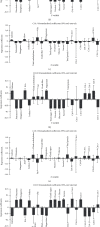Valorization of Olive Pruning Residues through Bioconversion into Edible Mushroom Pleurotus ostreatus (Jacq. Ex Fr.) P. Kumm. (1871) of Improved Nutritional Value
- PMID: 32774986
- PMCID: PMC7407021
- DOI: 10.1155/2020/3950357
Valorization of Olive Pruning Residues through Bioconversion into Edible Mushroom Pleurotus ostreatus (Jacq. Ex Fr.) P. Kumm. (1871) of Improved Nutritional Value
Abstract
In several Mediterranean countries, olive pruning residues (OLPRs) are abandoned or burned leading to several environmental problems. Valorization of these agrowastes could be a challenge for the primary decomposer Pleurotus ostreatus, turning them into edible biomass. The OLPR was used alone (OLPR), or in mixtures with wheat straw (WS : OLPR 1 : 3 v/v and WS : OLPR 3 : 1 v/v). Mycelial colonization was hastened by 3.7 days in WS : OLPR 1 : 3 (v/v). Yields were comparable to control (WS) in WS : OLPR 3 : 1 (v/v). Organic matter loss decreased with increasing proportions of OLPR in substrates. The nutritional value of mushrooms was improved by lower fat and sodium contents, in WS : OLPR 1 : 3 (v/v) and WS : OLPR 3 : 1 (v/v), and higher total protein, crude fiber, iron, and total carbohydrates contents in WS : OLPR 3 : 1 (v/v), compared with those of control. Polyunsaturated fatty acids, mainly linoleic acid, were the most abundant in mushrooms. Monounsaturated fatty acids increased in mushrooms of the substrates containing OLPR. A good predictive model of partial least square regression analysis showed different relationships of mushroom palmitic, oleic, linolenic, palmitoleic, and stearic acids with substrate composition. Findings suggested the use of OLPR as a supplement to commercial wheat straw and as a tool to reduce the negative impacts of their hazardous disposal on the environment.
Copyright © 2020 Sami Abou Fayssal et al.
Conflict of interest statement
The authors declare no conflicts of interest.
Figures




Similar articles
-
Valorization of agro-forest wastes (oak acorns, vineyard pruning, and olive pruning) through the cultivation of shiitake (Lentinula edodes) mushrooms.Heliyon. 2024 Jun 15;10(12):e32562. doi: 10.1016/j.heliyon.2024.e32562. eCollection 2024 Jun 30. Heliyon. 2024. PMID: 38994102 Free PMC article.
-
Combined effect of olive pruning residues and spent coffee grounds on Pleurotus ostreatus production, composition, and nutritional value.PLoS One. 2021 Sep 24;16(9):e0255794. doi: 10.1371/journal.pone.0255794. eCollection 2021. PLoS One. 2021. PMID: 34559813 Free PMC article.
-
Pleurotus ostreatus Grown on Agro-Industrial Residues: Studies on Microbial Contamination and Shelf-Life Prediction under Different Packaging Types and Storage Temperatures.Foods. 2023 Jan 24;12(3):524. doi: 10.3390/foods12030524. Foods. 2023. PMID: 36766053 Free PMC article.
-
Pre- and Postharvest Strategies for Pleurotus ostreatus Mushroom in a Circular Economy Approach.Foods. 2024 May 9;13(10):1464. doi: 10.3390/foods13101464. Foods. 2024. PMID: 38790763 Free PMC article. Review.
-
Edible mushrooms as a ubiquitous source of essential fatty acids.Food Res Int. 2019 Nov;125:108524. doi: 10.1016/j.foodres.2019.108524. Epub 2019 Jun 24. Food Res Int. 2019. PMID: 31554069 Review.
Cited by
-
Valorization of agro-forest wastes (oak acorns, vineyard pruning, and olive pruning) through the cultivation of shiitake (Lentinula edodes) mushrooms.Heliyon. 2024 Jun 15;10(12):e32562. doi: 10.1016/j.heliyon.2024.e32562. eCollection 2024 Jun 30. Heliyon. 2024. PMID: 38994102 Free PMC article.
-
Nano urea effects on Pleurotus ostreatus nutritional value depending on the dose and timing of application.Sci Rep. 2021 Mar 10;11(1):5588. doi: 10.1038/s41598-021-85191-9. Sci Rep. 2021. PMID: 33692465 Free PMC article.
-
Spatial Assessment of Potentially Toxic Elements (PTE) Concentration in Agaricus bisporus Mushroom Collected from Local Vegetable Markets of Uttarakhand State, India.J Fungi (Basel). 2022 Apr 27;8(5):452. doi: 10.3390/jof8050452. J Fungi (Basel). 2022. PMID: 35628708 Free PMC article.
-
Combined effect of olive pruning residues and spent coffee grounds on Pleurotus ostreatus production, composition, and nutritional value.PLoS One. 2021 Sep 24;16(9):e0255794. doi: 10.1371/journal.pone.0255794. eCollection 2021. PLoS One. 2021. PMID: 34559813 Free PMC article.
-
Production and composition of Pleurotus ostreatus cultivated on Lithovit®-Amino25 supplemented spent substrate.AMB Express. 2020 Oct 21;10(1):188. doi: 10.1186/s13568-020-01124-1. AMB Express. 2020. PMID: 33084956 Free PMC article.
References
-
- Senatore F., Dini A., Marino A., Schettino O. Chemical constituents of some basidiomycetes. Journal of the Science of Food and Agriculture. 1988;45(4):337–345. doi: 10.1002/jsfa.2740450408. - DOI
-
- Croan S. C. Conversion of conifer wastes into edible and medicinal mushrooms. Forest Products Journal. 2004;54:68–76.
LinkOut - more resources
Full Text Sources

